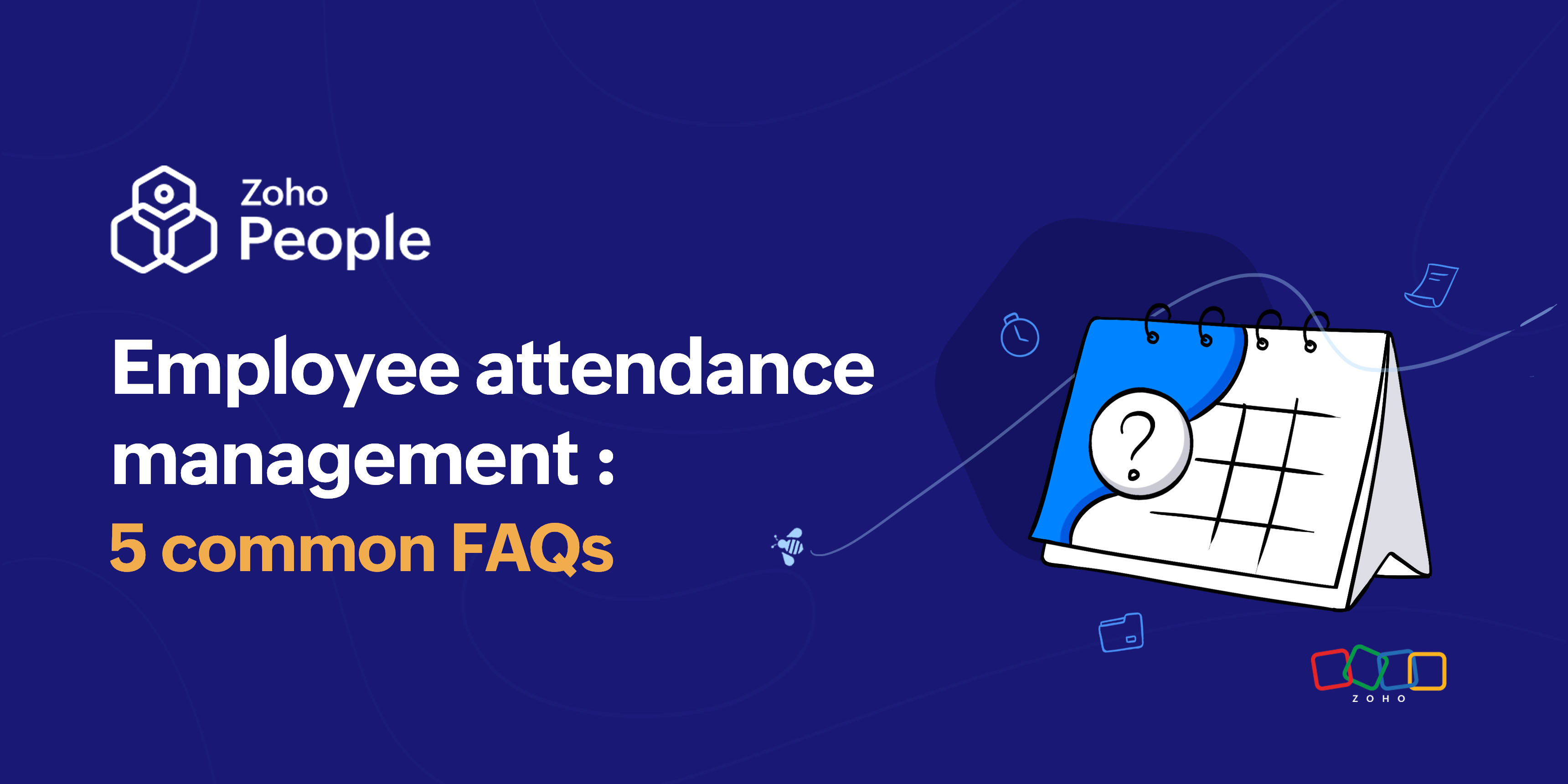- HOME
- More
- On Zoho People
- 5 common questions associated with employee attendance management
5 common questions associated with employee attendance management
- Last Updated : November 28, 2023
- 1.1K Views
- 4 Min Read

Tracking employee attendance is an essential HR operation that ensures your organization pays employees accurately and complies with labor laws. Streamlining your employee attendance management practices means you'll be able to recognize employee attendance patterns and identify unscheduled absenteeism, tardiness, and similar issues that can damage productivity. If you're looking to establish an attendance process at your organization, we have answers to five commonly asked questions associated with employee attendance management.
What are the different types of attendance tracking?
A proper attendance tracking process is crucial for monitoring employee attendance patterns and documenting attendance data for compliance and payroll processing. Here are some of the common ways to track employee attendance:
Attendance management system
An intuitive HR tech tool, the attendance management system empowers employees to mark their attendance online through web and mobile applications. Their working hours are calculated and stored in its database automatically.
Biometric devices
These devices, usually installed at the entrance of a workplace, use employees' distinct features like their iris, fingerprints, and other facial characteristics to mark attendance. When employees check in and out with biometric devices, their working hours will be calculated and stored in the system.
Spreadsheets
HR teams often create spreadsheets that employees use to enter their time-in and time-out data. Once HR collects all data for a specific period, the team can easily calculate total working hours. Overtime and leave data are also usually entered in the same sheet manually.
Physical registers
A manual register is usually left at reception, and employees record their office-in and office-out time along with their signature every day. Then, the total working hours are calculated manually by HR teams. This approach to attendance tracking can be tedious.
Learn more about the different ways to track employee time and attendance.
What is the best way to track employee attendance?
Using an attendance management system is one of the best ways to track employee attendance. Your employees can mark their attendance with a click of a button and this data will be documented automatically. Features like IP restrictions, geo-restrictions, and facial recognition can make the data more accurate. These systems also integrate with payroll systems so that the attendance data is automatically pushed for payroll calculation. Intuitive reports that come with the system provide a bird's-eye view of who's in and who's out so that it's easy to delegate work. Plus, the user access controls that come with the system ensure that the right people have access to attendance data.
How do you write a good attendance policy?
A good attendance policy will include everything that's expected from employees in terms of attendance, including how employees should mark attendance, the number of hours they're expected to be at the office, how their overtime hours will be calculated, how they can request permissions during their workday, how their shifts will be assigned, and what counts as tardiness and absenteeism. It should also define the disciplinary actions that you'd undertake if in case employees fall short of the regulations mentioned in the policy.
Also read: 5 tips to draft your first attendance policy
How do you maintain attendance compliance?
As you begin, it's essential to stay on top of all the labor laws about attendance governing your region. For instance, certain labor laws state that employees should not be made to work for more than 48 hours per week, and employees working more than that are entitled to fair overtime pay. For this, you must monitor and document your employees' working hours diligently to ensure that your employees are treated fairly. Similarly, the Fair Labor Standards Act requires organizations to document accurate records of the total number of hours worked by non-exempt employees. Since labor laws differ from region to region, it's essential that you be in the know of the laws that apply to your organization and streamline your compliance procedures accordingly.
How can you improve the attendance system?
Taking steps to improve your attendance processes can have a great impact on your organization's productivity and bottom line. At the outset, set clear expectations about your organization's expected working hours and other attendance policies. Integrate your attendance and payroll systems tightly so that you don't underpay or overpay your employees. Use an attendance tracking system to automate your attendance operations, empower employees to mark attendance on the go, and store attendance data in a centralized repository.
Wrapping up
Having a clear-cut procedure to track your employees' attendance can level your organization's productivity and provide a wonderful working experience for your employees. We hope this blog post answers all your questions about employee attendance management. Zoho People, our all-encompassing HR software, comes with an intuitive attendance tracker that tracks employee working hours and provides greater clarity over the attendance trends at your organization. Learn more about Zoho People's attendance tracker.
Also see:Top 5 mistakes that hinder effective attendance management
 Tarika
TarikaContent Specialist at Zoho People


